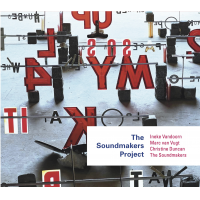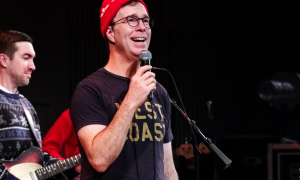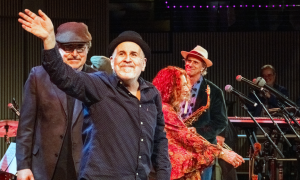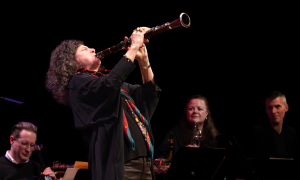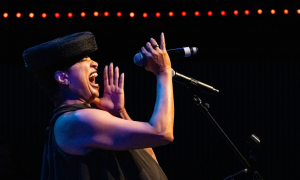Home » Jazz Articles » Live Review » Moers Festival 2014
Moers Festival 2014

Moers Festival
Moers , Germany
June, 6-9, 2014
Moers is a small city of about 100,000 inhabitants at the periphery of the former mining and industrial Ruhrpott area in Germany, about 40 km from the Dutch border and near the cities of Duisburg and Düsseldorf. Moers Festival, a four-day annual event always taking place on White Sunday, is a special festival with a rich history and firm traditions. Originally named Moers International New Jazz Festival, it grew into a remarkable cultural enterprise through which the city has become world-famous among musicians, music aficionados, festival directors and cultural entrepreneurs.
Great changes, new beginnings, stable future
This year the festival had to relocate to a hall to a new place on the periphery of the city, and make a new start with this year's 19 main acts spread over four days and nights. Those 19 main acts were augmented by daily sessions starting at 11:00 in the morning, night sessions starting after midnight and special concerts in the dark. The morning sessions brought together festival artists, musicians from the region and other guest musicians. This year's edition was a big challenge due to the relocation of the festival activities and the task to resettle everything, establish the new surroundings and make everything work. It is still an event where visitors may stay during the festival in their mobile homes and tents next to the festival hall.
Friday night
The festival opened with reminiscences of legendary bassist Peter Kowald (1944-2002), originating from the close-by city of Wuppertal, cofounder of the festival and closely related to its heydays during the '80s and '90s. It became a very special thing, initiated and organized by Cologne double bassist Sebastian Gramms, who played Kowald's bass: standing in three rows, 44 double bassists (mainly from the region)—including Mark Dresser and Dieter Manderscheid—performed together, starting with themes by Kowald. It took a lot of organizational effort to bring Bassmasse, as it was called, into being. To rehearse and perform with this amount of big violins, more than forty parking lot spots were required, for instance. Daring as it doubtlessly was to do this as the very first concert in a completely new concert hall, it set the tone, succeeded in overcoming limitations and crossing borders. It ultimately turned out to be a triumph for the music, the instrument, the musicians and the audience.
44 double basses onstage is spectacular but not necessarily a spectacle. When Dutch drummer Han Bennink entered the stage, however, people expected a spectacle. And: they got it, generally speaking. In Moers, he hit the stage together with young Dutch pianist Oscar Jan Hoogland. As an artist and musician Bennink does not just play his tune or drum his rhythms, he transforms found realities percussively. And that's what he did effectively and in a highly enjoyable way for the cheering audience in Moers. Actually, when you get an audience that sympathetic, the musicians couldn't help but do a good job. Bennink then acted as many people would like to have acted themselves. He is a tough partner for every duo.
Hoogland is a homeboy (of the youngest generation) who acts in the same vein. Even as Bennink was expanding his work field, so, too, did Hoogland during their performance. He switched from piano to his heavily amplified and distorted clavinet and employed an armada of megaphones. Whereas other musicians add a lot of textural noise to their music, Bennink and Hoogland relied on a quite old tradition of artfully building up obstacles that they had to cope with in inventive ways to make their way into playing bits of music. Together with some of Thelonious Monk's pivotal lines as companions, both became entangled in a highly idiosyncratic and amusing way during their stage ride.
From 44, then, two musicians and, finally, to just one musician with an ordinary acoustic guitar on the big stage: Marc Ribot. Ribot, too, has his characteristic idiosyncratic way. He is a master of overshooting the mark in a highly precise and productive way, and he is also a master of being inside and outside the piece of music, very closely connected. In Moers, he crept into the ingrained role of singer-songwriter, thereby derailing the pattern of the old protest song. Sometimes there was a sketchy song, sometimes a creased, scrunched up form of prototypes for '60s protest songs (the far echoes of P.F. Sloan's "Eve Of Destruction," for instance), more or less unfinished.
Picking and strumming his guitar, Ribot talked and sang his way through a series of serious topics, serious enough to express a protest ("The Empire State Building," "My Body Is Lying," "The Dying Cowboy," "Santa Claus," The Internet"). A special aspect of the Ribot-parlando: his rendition of Bob Dylan's legendary "Masters Of War." First talking about the great feeling of playing a D-minor chord when he was a young guy ("Masters," from 1963, leans on the British folksong "Nottamun Town" which is in a major key; Dylan's minor gave it the definite doom-struck effect). Ribot ended with a hyper-rapid recitation of the song's lyrics. Although confusing or bothering parts of the audience, it was very much a Ribot thing: productively escaping the preset gusto framing, supplying food for thought and readjusting perceptions.
A big contrast, then, with the last group of the first night, the 16-member Ricky-Tick Big Band from Helsinki, augmented by Julkinen Sana (Public Address). Julkinen Sana, a highly infectious rap trio of acclaimed Finnish hip hop pioneers consists of Paleface, Redrama and Tommy Lindgren (Father Metro), The Ricky-Tick BB—founded in 2010 by its leader, guitarist/composer/producer Valtteri Laurell Pöyhönen, now residing in Berlin—is an all-star big band of top young jazz musicians from the younger Finish generation. It was revealed, very quickly, as being more than just a dynamic and groovy modern Big Band with some vocalists as guests. All three vocalists were natural born, high energy entertainers who made immediately contact with the audience, let it participate and shared with it the joy of the strong groove and the bright Big Band sound, stirring it up, conquering it and altogether making its first appearance outside Finland a surprisingly strong overall experience.
Saturday
The afternoon started with the truly heavy PNLU, the newly formed large ensemble from titanic Norwegian drummer Paal Nilssen-Love. Moers artistic director Reiner Michalke saw the first appearance of this ensemble at last summer's Molde International Jazz Festival in Norway—an utterly convincing performance, according to many witnesses (this author included). It united nine strong and powerful musicians of the younger generation from Norway and Sweden from different upcoming groups, with Oslo's well-known, hardcore electronics and graphics man Lasse Marhaug.
The Moers performance started with the last piece of the ensemble's Molde concert, in such full overdrive that it first seemed that all the richness of the layers would be swallowed or buried. But the opposite happened in a gripping way, working out overwhelmingly as it became a true brand. A crucial role was played by the powerful and lengthy soaring of baritone saxophonist Klaus Holm. The horn section—normally consists of trumpeter Thomas Johansson, trombonist Mats Äleklint Quartet, tubaist Børre Mølstad, and saxophonists Kasper Værnes and Klaus Holm—had to compensate for Äleklint, one of the most prolific young trombonists of the moment, who could not make it to this concert. Johansson, Mølstad, Værnes, and especially Holm, did it a bravura. They were carried and propelled, with heavy fire, by guitarist Ketil Gutvik, bassists Jon Rune Strøm and Christian Meaas Svendsen, and Andreas Wildhagen as a second drummer.
The whole convincing and cutting performance had just one flaw: it lasted 20 seconds too long. In PNLU a lot of new things unite in strong and convincing shape, on a new level, firing inside and outside, making a strong mark.
It went on with drums but, by way of contrast with intimate duo work of Joey Baron and Robyn Schulkowsky. Baron, a regular Moers performer, was a well-known musician to festival visitors, whereas Schulkowsky was the dark horse for most of them, maybe also because she mainly works in the field of contemporary composed music. But Michalke is one of the few festival directors who is unafraid of unknown airs (and also not creating extra baskets for it). Also, to some part of the audience, a whole set with drums seemed to promise not enough real music.
It is still astonishing that the drums, one of the most primal and ancient means of human musical expression prior to articulated human language, was perceived only as a synchronizing driving mechanism, or as a break-filler. This perception has been reinforced by the mass consumption of music as a recorded artifact. The richness of sound and drumming all the time around us, is perceived mainly subconsciously, and most of it is not paid attention to or really taken in. A drum or percussion discussion takes place in the continuum between the two aforementioned spheres, and Baron and Schulkowsky gradually moved from the more familiar to the unfamiliar, picking their audience up with modest playful grooves and leading them into a more complex shimmering, layer of sounds including some wonderful rain music. It was a highly enjoyable affair, a great example of female and male modes and the way sound-making can respectfully interlock.
During a festival day with concerts going on from 11 am until long after midnight, it is almost impossible to stay permanently on track, with the same degree of presence and attention. The Paris-based French/Belgian/Italian power trio of trumpeter Jean Louis Aymeric Avice, bassist Joachim Florent and drummer Francesco Pastacaldi did not find me in receiving mode. It was a loud affair, worth checking out by those who liked its uncompromising, right in-your-face music, last heard on Uranus (Coax Records).
Orchestre National de Jazz (ONJ) is a longstanding French institution, an ensemble with a strictly limited working term, changing leadership—and, for every working period—new members as well. The current installation, under the leadership of guitarist Olivier Benoit, is a bit atypical because it also had a couple of well-established names among its ten members—including bassist BrunoChevillon, drummer Eric Echampard and pianist Sophie Agnel—beside highly impressive and promising talents such as saxophonist Alexandra Grimal and violinist Theo Ceccaldi Trio.
ONJ, as an instrument of its periodic leader, has always been a special tool for creating, producing and performing "big" works. Big, not only in the sense of orchestration and extended lineup, but also in terms of concept, references and projections. The first album from the present Benoit-led installation was titled Europe Paris, a work of five extended parts totaling more than 90 minutes.
Benoit's 11-piece ONJ presented a strong architectural type of music full of sensationalism, worn-out grandeur and strange, lingering wisps of sound, this was deeply serious music of far-reaching sound surfaces, huge columns and deep corridors—spaces well-suited for erratic, wandering sounds. It was also music full of ostinatos and ostinato-like structures, grandissimo riffs, and driving, accelerating and unfolding grooves perfectly suited for sophisticated soloing. The music did not miss its impressive effect on the audience.
Violinist Theo Ceccaldi (the new French wunderkind) and saxophonist Alexandra Grimal were the most outstanding soloists. Grimal can make a solid far-reaching sound flexible, with rich tonal colors and soul. Ceccaldi is a more highly alert Jack of all trades with a constant flow of ideas. Both definitely proved promising musicians to keep an ear on.
Norwegian trumpeter Sjur Miljeteig has had a varied career so far. He participated in Jaga Jazzist during its formative years; collaborated with Shining a few times, and had a longer stint with singer Solveig Slettahjell's Slow Motion Orchestra. He released his debut solo album It's Funny How Things Happen at Particular Times in 2013—an album of somewhat surreal, catchy electro-acoustic landscapes. His quintet possesses notable instrumentation pointing in that direction: two keyboardists (Marte Eberson, and Øystein Skar), guitar (Olav Torget) and drums (Per Oddvar Johansen), all apt to lay down spacey sound layers within which to embed his trumpet sounds and let them pullulate.
The music interbred modal lines and the transpositions of said lines with '80s synth-pop and drum machines opening up new perspectives. The group's Moers appearance was its first outside of Norway, and revealed a fresh approach, resulting in appealing and, at times, fascinating new combinations of heavily loaded lightness. It was another strong example of the inexhaustible source of creative musical variation from the Norwegian scene, and it was remarkable how, via different open collaborations and participation in evolving groups, new creative concepts emerge which lead into new groups possessed of their very own signature.
The final act of the second day was no less than the Sun Ra Arkestra, as passed by the astral master to the eldest of the musicians on planet earth, first John Gilmore and now Marshall Allen—who, meanwhile, was entering Methusalean dimensions, just a week before he heard his 91st year ring. He was in good shape and mood, the band as stoned as Mount Everest. It became a lighthearted, heavy blues-loaded love affair, the Moers audience engaging in some intimately joyful dancing—on the floor or in its heads.
Herman P. Blount, as ever, made a special mark among his fellow musicians. Unlike the great Afro-American musicians called Earl (Earl Hines), Duke (Duke Ellington), Count (Count Basie) or King (Joe King Oliver), he adopted the heritage of Ra, the divine king of kings and forerunner of the space age which also became subject of ongoing signifying transpositions. The 12-piece band entered the stage in its costumed splendor, which gave its music making immediate attention and appeal.
Allen was not just conducting the band; he lead the landing and departing of the space ship on its never-ending journey. Slightly surreal, with fully joyous moments on its earthly home, the band celebrated the blues. Allen soloed on his horn or his Steiner electronic valve instrument, and the horn section blew as if the Basie band was back on planet Earth. The night sky smiled towards the new morning.
Sunday
Sunday started with a suitable poetry hour from German pianist Julia Hulsmann, ECM recording artist and this year's Improviser in Residence for the city of Moers. An institution now in its seventh year and changing annually, the Improviser is a musician who lives and works in Moers for a year, immersing him/herself in the town's cultural life. For her festival performance, Hülsmann joined forces with New York-based singer Theo Bleckmann—like Hülsmann, originating from the region—New Zealand-born saxophonist Hayden Chisholm from Cologne, and Berlin's young drummer Moritz Baumgärtner, setting poems by Margaret Atwood, amongst others, to newly written music.
Hülsmann is one of the most capable German pianists to work with singers, and the match with Bleckmann was bound to happen. Their performance was delicate and appealing, but, as of yet, lacked real fascination. A nice start, but not the big thing—yet. But more is in the making: the group will go into Oslo's Rainbow Studios soon, to record lesser-known Kurt Weill-songs for a new ECM album.
The duo match of drummer Jaki Liebezeit (of former Cologne-based cult band Can) with contemporary composer Marcus Schmickler's electronics seemed highly promising, the announcement in the program challenging. However their monotonous performance crashed dead on the ground.
After that it became baritone saxophonist Josh Sinton's task to bring the festival back to life. After two earlier appearances at the Moers Festival, Sinton made a reentry with his own group, Ideal Bread, consisting of cornetistKirk Knuffke, double bassist Adam Hopkins and drummer Tomas Fujiwara. A point of reference for Ideal Bread's music: the late soprano saxophonist Steve Lacy, who died ten years ago. The group has just released the 30-track Beating The Teens—The Songs Of Steve Lacy (Cuneiform), its third album. Ideal Bread was jazz in its purest form: unadorned, loose and edgy with a direct, rough sound and, at the same time, sophisticated musical elaborations. The group presented compact music with great dynamics to the Moers audience's great delight. It felt like an at-home match and was a perfect trailblazer for Fred Frith's renewed 12-piece edition of the Gravity Band, which hit the stage next.
Frith's Gravity work, dating back to his 1980 recording (with Swedish band Samla Mammas Mana and Maryland, USA band The Muffins), appeared attractive, challenging and fresh enough for a rejuvenated bunch of eager young musicians comprised of violinist Kaethe Hostetter, saxophonist Kasey Knudsen, clarinetist Aaron Novik accordionist Marihito Ayabe, sampler Jon Leidecker keyboardist Dominique Leone, guitarist Ava Mendoza, bassist Lisa Mezzacappa, drummer Jordan Glenn percussionist William Winant and sound engineer Myles Boisen. The band rendered a wonderfully fresh performance of strong, durable material. Starting with a "Here We Go Around the Mulberry Bush" feel, wandering along allusions to dub reggae and other popular genres in a very Frithian way, this was a real joyous festival affair due to a great musical crew. It could have been a fine finale but it was the opening act for the second part of the day, with more to come.
There are performances which make something (more) real happen. This is what clearly went on when drummer Paal Nilssen-Love and Arto Lindsay, with his worn-out blue electric guitar, hit the Moers stage. They made a big, joyful noise—ingeniously infectious noise comanding the soul to sing out, and kindling euphoria and pure joy. Nilssen-Love beat his drum like a berserker which, together with Lindsay's unerring, merry and sloping noise-making on guitar, had an enormously uplifting effect. They were both apparently acting from a deeper musical feeling, which induced a surpassingly magical effect, unexplainable but clearly sensible. At first sight a duo with Nilssen-Love and Lindsay may seem odd and improbable but it turned out to be a hit—the highlight of the night. It was their second meeting after a recent impromptu performance at Rio de Janeiro's Audio-Rebel club. Moers had the same—or even higher—intensity. Magic from a deeper p(l)ace.
Sunday night's final concert brought another kind of full Brazilian sound made by Letieres Leite's 20-piece Bahian Orkestra Rumpilezz. In Europe it is a less—known tradition from the Northeast of Brazil, which is transferred to the orchestra's extended horn section, infused by and interbred with jazz influences. It became a visually and musically spectacular, festive affair and again grand finale.
Sessions
The morning sessions on Saturday, Sunday and Monday are considered "the lifeblood of the Moers Festival; the "early" morning ritual in which the original spirit of the event expresses itself most clearly." Every morning two series of sessions were held under the curatorship of saxophonist Jan Klare. Musicians from the main program and musicians exclusively invited for the sessions gathered here in various combinations for on-the-spot spontaneous creations, to "celebrate what is at the heart of their respective musical worlds: improvisation—as pure as it gets and as exciting as the audience demands." Although running in the morning at the town's Music School, the sessions were very well-attended, both by locals and visitors from elsewhere. The sessions were a good occasion to experience and check out festival artists in a more intimate context and in unusual combinations.
During the Moers Festival, creating and making music goes on for almost 24 hours each day. After the main program there were the night sessions at local club Die Röhre, with Benny Greb'/ Moving Parts (keyboardist Kit Downes, guitarist Chris Montague) and Little fishermen: the harbor pub beat-up featuring saxophonist Niels Klein, keyboardist Florian Ross, DJ Illvibe, bassists Claus Fischer, drummer Tim Dudek—and a trio with guitarist Hanno Busch, bassist Claus Fischer and, again, drummer Dudek.
As a big surprise the festival also offered, at the last minute, a Sunday night program with three concerts: first, a concert featuring two musicians from Canadian alt-rock band Arcade Fire's Reflektor Tour), violinist Sarah Neufeld and saxophonist Colin Stetson; a newly formed duo which director Michalke hired on short notice after seeing them premiere just two weeks earlier at the Festival International de Musique Actuelle Victoriaville, in Canada; and third, a concert from Canadian sound artist Tim Hecker and British sound experimenter Greg Haines.
It will hitherto have become clear that the Moers Festival possesses both remarkable spirit and programming. The programming is not just diverse but full of stark contrasts, an underlying cohesion and well-balanced pan-European and all-American representation. It is characterized by musical abundance, not overkill—a festival with a curious, highly receptive and loyal audience which considers it as "their" festival.
Monday
Even the final day offered a highly attractive program with the usual morning sessions starting in the early afternoon, with four heavy groups: from Israel, the Avi Lebovich Orchestra; Johanna Borchert's Wayside Wayfarer, with Fred Frith, Shazhad Ismaily and Julian Sartorius; Ava Mendoza Unnatural Ways; and, finally, the new red-hot version of Mostly Other People Do the Killing.
Ok, here we go: another 12-piece orchestra, this time a band of bandleaders from Israel with four saxophones, three trombones, two trumpets, guitar, bass and drums. It seems jazz is very much alive, as evidenced by all the big ensembles that festivals are booking... And trombonist Avi Lebovich's troupe really had something to offer, much more than the heavily "Hava Nagila"-loaded opening piece suggested. The orchestra was making its first appearance in Germany, and manifested itself as an excellent vehicle for sophisticated pieces and sparkling renditions. Either with a waltz in Pat Metheny mode or melancholia in heavy brass, but above all interspersed by that special eastern coloring only heard in Israeli jazz.
Next were two groups belonging to up-and-coming female musicians: German pianist/singer Johanna Borchert, who is working in Berlin and Copenhagen; and Brooklyn guitarist Ava Mendoza. The contrast could not be bigger between these two female musicians, with Fred Frith as a connecting link.
Borchert was a guest of the festival in 2010, with the Copenhagen-based and award-winning Schneeweiß & Rosenrot, and again in 2011 with Little Red Big Bang, a small Big Band extension of her duo with Spanish-Danish singer Elena Setien, both bands freely crossing and shaping the no-man's land between jazz and pop. Now she was back with a new outfit, in the main role as singer, and a prestigious, heavy lineup for the live premiere of Wayside Wayfarer. A month earlier she had already performed parts of it solo at Jazzahead! in Bremen, which begged the question: how would Frith, Ismaily and Sartorius fill in and shape their roles?
The work was characterized by constant overflows between song, soundscape and deepening lines and structures. The intimate songs unfolded by various means including a delicate balance of contouring, atmospheric breezes, invading disturbances, accelerations and pointed accents. Borchert's singing voice and expression were pointed and subdued, with careful coloring, but it was also impalpable and a bit complacent, which veiled the inner urge and impeded its reception. Her album Desert Road, with this lineup, will soon be released on the Enja Soulfood label.
Ava Mendoza's heavy rock-oriented Unnatural Ways, with bass guitarist Tim Dahl and drummer Nick Podgurski, manifested itself with its very own seizing dynamics, great contrasts, surprising turns, great climaxing and great broken beats. Mendoza's shouting and singing—an important integral part of the playing—was timed and articulated well, able to capture the body, mind and imagination. It facilitated getting into the music and being carried by it. A minor, more common flaw: restarting when the music was already beyond its climax. Shorter would have been stronger. All in all, however, a good transition to the rawness and craziness of the final band. Mostly Other People Do The Killing (MOPDTK) premiered as a quartet in 2009, for the first time, at the Moers Festival. Now it returned, extended to a septet, to mimic the pre-WWII style of jazz of territory bands. Four new musicians came in: well-known bass trombonist Dave Taylor, banjoist Brandon Seabrook, pianist Ron Stabinsky and famous slide trumpeter Steven Bernstein, subbing for Peter Evans.
This incarnation of MOPDTK was definitely a rapidly racing, noisily colliding, regularly over-the-top jump-cut affair. Elliot's invention is the mimicking of historical styles in that crazy way and thereby recreating—on a playful meta-level—an effect or feeling comparable to the craziness of the original style in its own historical timeframe. It was, for the most part, a well-rehearsed show which had to look, sound and feel fully spontaneous, including some kind of unintended derailing and bold rescuing. It worked grandiose.
A special thing was Seabrook's stupendous attempts to bring the banjo back into picture—not an easy way of simply amplifying the instrument. Through his approach and his messing around with electronics, he created tense contrasts and undermining dialects as barbs. Focused and inventive soloing was possible in the Red Hot context, as demonstrated by saxophonist Jon Irabagon and Bernstein, in their joint action on soprillo and slide trumpet respectively, as well as in Stabinsky's weird piano introduction to "King Of Prussia."
So many ways, productive findings, and discoveries; so many challenges; and such open receptiveness of the Moers Festival visitors, watchers and listeners. More than reason enough to go on Moersing. Roll on May 22-25, 2015!
Many of the concerts are available on demand as videos on ARTE-TV and are easy to find also via the Moers Festival website.
Photo Credits
Henning Bolte
Tags
Live Reviews
Henning Bolte
Germany
Dusseldorf
Peter Kowald
Mark Dresser
Dieter Manderscheid
Han Bennink
Thelonious Monk
Marc Ribot
Bob Dylan
Paal Nilssen-Love
Lasse Marhaug
Mats Äleklint
Kasper Værnes
Jon Rune Strøm
Christian Meaas Svendsen
Andreas Wildhagen
Joey Baron
Bruno Chevillon
Eric Echampard
Sophie Agnel
Alexandra Grimal
Théo Ceccaldi
Jaga Jazzist
Shining
Solveig Slettahjell
Olav Torget
Per Oddvar Johansen
Sun Ra Arkestra
John Gilmore
Marshall Allen
Earl Hines
duke ellington
Count Basie
Joe King Oliver
Julia Hulsmann
Theo Bleckmann
Hayden Chisholm
Moritz Baumgärtner
Josh Sinton
Kirk Knuffke
Adam Hopkins
Tomas Fujiwara
Steve Lacy
Fred Frith
Kasey Knudsen
Aaron Novik
Marië Abe
Ava Mendoza
lisa mezzacappa
Jordan Glenn
William Winant
Arto Lindsay
Jan Klare
Benny Greb
Kit Downes
Chris Montague
Florian Ross
Claus Fischer
Colin Stetson
Avi Lebovich
Julian Sartorius
Mostly Other People Do the Killing
pat metheny
Tim Dahl
Dave Taylor
Brandon Seabrook
Ron Stabinsky
Steven Bernstein
Peter Evans
Jon Irabagon
PREVIOUS / NEXT
Support All About Jazz
 All About Jazz has been a pillar of jazz since 1995, championing it as an art form and, more importantly, supporting the musicians who make it. Our enduring commitment has made "AAJ" one of the most culturally important websites of its kind, read by hundreds of thousands of fans, musicians and industry figures every month.
All About Jazz has been a pillar of jazz since 1995, championing it as an art form and, more importantly, supporting the musicians who make it. Our enduring commitment has made "AAJ" one of the most culturally important websites of its kind, read by hundreds of thousands of fans, musicians and industry figures every month.











